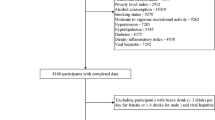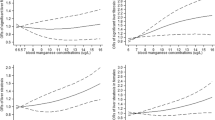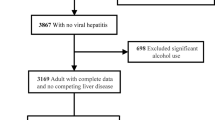Abstract
The associations between selenium and liver stiffness and steatosis remain uncertain. This study aimed to explore the clinical relevance of selenium with liver stiffness and steatosis in adults from the 2017–2018 National Health and Nutrition Examination Survey. Subjects with excessive alcohol consumption and hepatitis B or C infection were excluded. Liver stiffness and steatosis were detected by transient elastography. Dietary selenium intakes and blood selenium concentrations were included as exposures. In multivariate analysis without adjustment for obesity, higher dietary selenium intakes (tertile 3 vs. tertile 1) were positively associated with liver stiffness in females (odds ratio (95% confidence interval): 2.64 (1.88–3.70)), and were positively associated with liver steatosis overall (1.54 (1.20–1.97)) and also in males (1.55 (1.06–2.26)). In multivariate analysis without adjustment for obesity, higher blood selenium concentrations (tertile 3 vs. tertile 1) were positively associated with liver steatosis overall (1.33 (1.02–1.76)) and also in males (1.56 (1.13–2.16)). After further adjustment for obesity, the abovementioned associations remain significant between dietary selenium intakes and liver stiffness in females (2.29 (1.69–3.12)) and liver steatosis overall (1.37 (1.01–1.86)), and between blood selenium concentrations and liver steatosis in males (1.67 (1.25–2.21)). Dose–response analysis showed that the abovementioned associations were linear. However, dietary selenium intakes meeting the recommended daily allowance (≥ 55 µg/day) were not associated with liver stiffness (0.99 (0.62–1.55)) and steatosis (1.01 (0.69–1.49)). In conclusion, higher dietary selenium intakes and blood selenium concentrations were positively associated with liver stiffness and steatosis, and obesity may partially account for the observed associations.
Similar content being viewed by others
Data Availability
All data are freely available in the NHANES: https://www.cdc.gov/nchs/nhanes/.
References
Huang DQ, El-Serag HB, Loomba R (2021) Global epidemiology of NAFLD-related HCC: trends, predictions, risk factors and prevention. Nat Rev Gastroenterol Hepatol 18:223–238
Younossi ZM, Koenig AB, Abdelatif D et al (2016) Global epidemiology of nonalcoholic fatty liver disease-meta-analytic assessment of prevalence, incidence, and outcomes. Hepatology 64:73–84
Abdelmalek MF (2021) Nonalcoholic fatty liver disease: another leap forward. Nat Rev Gastroenterol Hepatol 18:85–86
Younossi ZM, Corey KE, Lim JK (2021) AGA clinical practice update on lifestyle modification using diet and exercise to achieve weight loss in the management of nonalcoholic fatty liver disease: expert review. Gastroenterology 160:912–918
Parra-Vargas M, Rodriguez-Echevarria R, Jimenez-Chillaron JC (2020) Nutritional approaches for the management of nonalcoholic fatty liver disease: an evidence-based review. Nutrients 12(12):3860
Institute of Medicine (US) Panel on Dietary Antioxidants and Related Compounds (2000) Dietary reference intakes for vitamin c, vitamin e, selenium, and carotenoids. Washington (DC): National Academies Press (US). https://doi.org/10.17226/9810
Polyzos SA, Kountouras J, Goulas A et al (2020) Selenium and selenoprotein P in nonalcoholic fatty liver disease. Hormones (Athens) 19:61–72
Bonnefont-Rousselot D, Ratziu V, Giral P et al (2006) Blood oxidative stress markers are unreliable markers of hepatic steatosis. Aliment Pharmacol Ther 23:91–98
Guo CH, Chen PC, Ko WS (2013) Status of essential trace minerals and oxidative stress in viral hepatitis C patients with nonalcoholic fatty liver disease. Int J Med Sci 10:730–737
Yang Z, Yan C, Liu G et al (2016) Plasma selenium levels and nonalcoholic fatty liver disease in Chinese adults: a cross-sectional analysis. Sci Rep 6:37288
Zhang X, Heredia NI, Balakrishnan M et al (2021) Prevalence and factors associated with NAFLD detected by vibration controlled transient elastography among US adults: Results from NHANES 2017-2018. PLoS One 16:e0252164
Kim D, Konyn P, Cholankeril G et al (2021) Physical activity is associated with nonalcoholic fatty liver disease and significant fibrosis measured by fibroscan. Clin Gastroenterol Hepatol S1542-3565(21):00693–5
Torres DM, Harrison SA (2008) Diagnosis and therapy of nonalcoholic steatohepatitis. Gastroenterology 134:1682–1698
Chalasani N, Younossi Z, Lavine JE et al (2018) The diagnosis and management of nonalcoholic fatty liver disease: practice guidance from the American Association for the Study of Liver Diseases. Hepatology 67:328–357
European Association for the Study of the Liver (2016) EASL-EASD-EASO Clinical Practice Guidelines for the management of non-alcoholic fatty liver disease. J Hepatol 64:1388–1402
Castera L, Friedrich-Rust M, Loomba R (2019) Noninvasive assessment of liver disease in patients with nonalcoholic fatty liver disease. Gastroenterology 156:1264-1281 e1264
Vinceti M, Filippini T, Wise LA et al (2021) A systematic review and dose-response meta-analysis of exposure to environmental selenium and the risk of type 2 diabetes in nonexperimental studies. Environ Res 197:111210
Zhou L, Luo C, Yin J et al (2020) Diverse associations of plasma selenium concentrations and SELENOP gene polymorphism with metabolic syndrome and its components. Oxid Med Cell Longev 2020:5343014
Lu CW, Chang HH, Yang KC et al (2019) Gender differences with dose(-)response relationship between serum selenium levels and metabolic syndrome-a case-control study. Nutrients 11(2):477
Fang C, Wu W, Gu X et al (2019) Association of serum copper, zinc and selenium levels with risk of metabolic syndrome: a nested case-control study of middle-aged and older Chinese adults. J Trace Elem Med Biol 52:209–215
Yuan Z, Xu X, Ye H et al (2015) High levels of plasma selenium are associated with metabolic syndrome and elevated fasting plasma glucose in a Chinese population: a case-control study. J Trace Elem Med Biol 32:189–194
Leung CW, Tapper EB (2021) Sugar-sweetened beverages are associated with increased liver stiffness and steatosis among apparently healthy adults in the United States. Clin Gastroenterol Hepatol S1542-3565(21):00591–7
Singh S, Muir AJ, Dieterich DT et al (2017) American Gastroenterological Association Institute technical review on the role of elastography in chronic liver diseases. Gastroenterology 152:1544–1577
Karlas T, Petroff D, Sasso M et al (2017) Individual patient data meta-analysis of controlled attenuation parameter (CAP) technology for assessing steatosis. J Hepatol 66:1022–1030
Menke A, Casagrande S, Geiss L et al (2015) Prevalence of and trends in diabetes among adults in the United States, 1988–2012. JAMA 314:1021–1029
Whelton PK, Carey RM, Aronow WS et al (2018) 2017 ACC/AHA/AAPA/ABC/ACPM/AGS/APhA/ASH/ASPC/NMA/PCNA guideline for the prevention, detection, evaluation, and management of high blood pressure in adults: executive summary: a report of the American College of Cardiology/American Heart Association Task Force on clinical practice guidelines. J Am Coll Cardiol 71:2199–2269
Desquilbet L, Mariotti F (2010) Dose-response analyses using restricted cubic spline functions in public health research. Stat Med 29:1037–1057
Siddiqui MS, Vuppalanchi R, Van Natta ML et al (2019) Vibration-controlled transient elastography to assess fibrosis and steatosis in patients with nonalcoholic fatty liver disease. Clin Gastroenterol Hepatol 17:156-163 e152
Wu J, Zeng C, Yang Z et al (2020) Association between dietary selenium intake and the prevalence of nonalcoholic fatty liver disease: a cross-sectional study. J Am Coll Nutr 39:103–111
Coelho JM, Cansancao K, Perez RM et al (2020) Association between serum and dietary antioxidant micronutrients and advanced liver fibrosis in non-alcoholic fatty liver disease: an observational study. PeerJ 8:e9838
Reja M, Makar M, Visaria A et al (2020) Increased serum selenium levels are associated with reduced risk of advanced liver fibrosis and all-cause mortality in NAFLD patients: National Health and Nutrition Examination Survey (NHANES) III. Ann Hepatol 19:635–640
Liu Y, Dong R, Yang Y et al (2021) Protective effect of organic selenium on oxidative damage and inflammatory reaction of rabbit kidney induced by T-2 toxin. Biol Trace Elem Res 199:1833–1842
Barroso CF, Pires LV, Santos LB et al (2021) Selenium nutritional status and glutathione peroxidase activity and its relationship with hemodialysis time in individuals living in a brazilian region with selenium-rich soil. Biol Trace Elem Res 199:2535–2542
Lu YY, Chen WL (2021) Clinical relevance of serum selenium levels and abdominal aortic calcification. Biol Trace Elem Res 199:2803–2810
Fang H, He X, Wu Y et al (2021) Association between selenium level in blood and glycolipid metabolism in residents of Enshi Prefecture, China. Biol Trace Elem Res 199:2456–2466
Wang C, Zhang L, Li L (2021) Association between selenium intake with chronic constipation and chronic diarrhea in adults: findings from the National Health and Nutrition Examination Survey. Biol Trace Elem Res 199:3205–3212
Vaghari-Tabari M, Jafari-Gharabaghlou D, Sadeghsoltani F et al (2021) Zinc and selenium in inflammatory bowel disease: trace elements with key roles? Biol Trace Elem Res 199:3190–3204
Kieliszek M, Bano I, Zare H (2021) A comprehensive review on selenium and its effects on human health and distribution in Middle Eastern countries. Biol Trace Elem Res. https://doi.org/10.17226/9810
Rayman MP (2020) Selenium intake, status, and health: a complex relationship. Hormones (Athens) 19:9–14
Vinceti M, Filippini T, Rothman KJ (2018) Selenium exposure and the risk of type 2 diabetes: a systematic review and meta-analysis. Eur J Epidemiol 33:789–810
Himoto T, Masaki T (2020) Current trends of essential trace elements in patients with chronic liver diseases. Nutrients 12(7):2084
Lv Q, Liang X, Nong K et al (2021) Advances in research on the toxicological effects of selenium. Bull Environ Contam Toxicol 106:715–726
Author information
Authors and Affiliations
Contributions
Xiaohui Liu: conceptualization, data curation, analysis and writing; Hong Shen, Mingfeng Chen: writing; Jun Shao: review and supervision.
Corresponding author
Ethics declarations
Ethics Approval
The NHANES is approved by the NCHS Research Ethics Review Board.
Conflict of Interest
The authors declare no competing interests.
Additional information
Publisher's Note
Springer Nature remains neutral with regard to jurisdictional claims in published maps and institutional affiliations.
Supplementary Information
Below is the link to the electronic supplementary material.
Rights and permissions
About this article
Cite this article
Liu, X., Shen, H., Chen, M. et al. Clinical Relevance of Selenium with Liver Stiffness and Steatosis Detected by Transient Elastography in Adults. Biol Trace Elem Res 200, 3041–3049 (2022). https://doi.org/10.1007/s12011-021-02912-x
Received:
Accepted:
Published:
Issue Date:
DOI: https://doi.org/10.1007/s12011-021-02912-x




